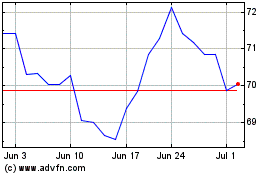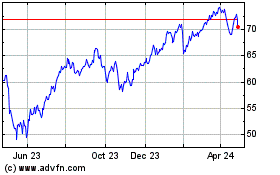Insurers Would Owe Under Proposed Financial-Crisis Tax
January 15 2010 - 4:43PM
Dow Jones News
A handful of large insurance companies, most of which turned
down government bailout funds, would likely owe money under the
proposed Financial Crisis Responsibility tax.
The proposed tax, unveiled Thursday by President Barack Obama,
would amount to 0.15% of total assets minus high-quality capital,
such as common stock, and disclosed and retained earnings.
Insurance-policy reserves would be untaxed, being already subject
to federal fees, according to the White House, but analysts and
insurers note that some details are yet to be clarified. The fee
must be approved by lawmakers; quite a few insurers would qualify
for the tax, according to analysts.
American International Group Inc. (AIG), MetLife Inc. (MET),
Prudential Financial Inc. (PRU) Allstate Corp. (ALL), Lincoln
National Corp. (LNC), Hartford Financial Services Group Inc. (HIG),
Ameriprise Financial Inc. (AMP) and Principal Financial Group (PFG)
all are eligible for the tax, based on total adjusted assets,
according to a Friday report by Credit Suisse.
A Sandler O'Neill research note on Friday came to some different
conclusions on which insurers would be taxed and added more names
to the list. Warren Buffett's Berkshire Hathaway Inc. (BRKA, BRKB),
Travelers Cos. Inc. (TRV), Aflac Corp. (AFL) and Genworth Financial
(GNW) would all have to pay the tax, in addition to the names
Credit Suisse cited.
AIG's main business is insurance, but it was the company's
financial trading business that led to its multi-billion-dollar
bailout. It would owe the most tax of the insurers, at an estimated
$388.8 million based on a full year, according to the Credit Suisse
estimate. Sandler O'Neill analyst Daniel Arnold put AIG's tax
burden at $420 million and generally had higher estimates for tax
liability for all the insurers.
Arnold noted the difficulty of interpreting what counts as Tier
1 capital when it comes to insurance companies, which don't
generally use the term. The tax is based on covered liabilities
calculated based on the company's assets minus Tier 1 capital and
excluding FDIC-assessed deposits and/or an adjustment for insurance
liabilities covered by state guarantee funds.
An AIG spokesman declined to comment on the bill.
Two other life insurers that took bailout funds would fall under
the tax, according to analysts. Hartford Financial received $3.4
billion from the Treasury's Capital Purchase Program and would owe
tax of about $28.2 million by Credit Suisse's estimate or about
$258.9 million, according to the Sandler O'Neill estimate.
Lincoln National received $950 million from the program and
would owe tax of about $29.4 million according to Credit Suisse, or
$134.9 million according to Sandler O'Neill.
Neither company immediately responded to a request for
comment.
Prudential and MetLife, two insurers that declined TARP funds,
would owe the second- and third-most under the tax, according to
Credit Suisse. Prudential would owe about $85.2 million, and
MetLife just over $81.5 million.
Prudential spokesman Bob DeFillippo said the company was working
on understanding the proposal and didn't yet have a comment.
A MetLife spokesman agreed with the assessment that the company
is included in the current proposal of companies that would owe the
tax but said the company is still looking at the details of the
proposed tax.
Berkshire Hathaway, which made stabilizing investments in
Goldman Sachs Group Inc. (GS) and General Electric Co. (GE) during
the financial crisis, would owe $133.4 million, according to
Sandler O'Neill. A Berkshire Hathaway spokeswoman didn't
immediately return a request for comment.
Allstate, which would owe $34.1 million according to Credit
Suisse, is also examining the proposal, a spokesman said.
Genworth and Aflac didn't immediately respond to a request for
comment.
One consequence of the tax falling on the biggest insurers is
that it would make them less competitive, said bank analyst Mike
Moebs of Lake Bluff, Ill. "This will help smaller insurers," Moebs
said. "It will put them in good position to compete," particularly
in specialized insurance markets.
-By Lavonne Kuykendall, Dow Jones Newswires; (312) 750 4141;
lavonne.kuykendall@dowjones.com
MetLife (NYSE:MET)
Historical Stock Chart
From Aug 2024 to Sep 2024

MetLife (NYSE:MET)
Historical Stock Chart
From Sep 2023 to Sep 2024
